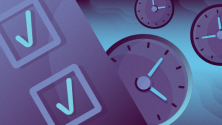Nothing To Hide is an "anti-stealth game," in which you must carry cameras and spy gear to live in a world of self-surveillance and self-censorship. A world where you're made to be your own watchdog. Released for The Day We Fight Back, the game is now seeking crowdfunding to complete the open source game—10% of what's raised will first go to the Electronic Frontier Foundation (EFF), Demand Progress, and the Freedom of the Press Foundation.
"The obvious inspiration for this game would be the recent Snowden revelations," said creator Nicky Case, "showing how far the National Surveillance Alliance (NSA) has over-stepped their boundaries." But he also drew inspiration from his own life. Case was born in Singapore, which he uses as the inspiration for Nothing To Hide's dystopia, a place he describes as "an obsessively clean world with huge government control over the media and free speech." He now lives in Silicon Valley and blames companies like Facebook and Google for damage to not only our privacy, but also public attitudes toward privacy.
He also spoke of the challenge of coming to terms with his sexuality within a conservative family and the importance of privacy to that process. "It's not about hiding things, it's about having a safe space to find out who you are," Case said.
Read on for more about what Case had to say about the game, why he created it, and the funding model he chose to support it.

Why do you believe releasing everything openly is important?
I didn't know it at the time, but open source and remix culture were crucial to me starting my career. When I was 9, I was learning to program by taking open source games and remixing the art and code to make the game my own. Eventually, I got good enough to code my own original games, but I've never forgotten how I got started.
And that's why I want to give back to the community! Nothing To Hide's art and code are completely open and dedicated to the public domain (CC0). Already, people are remixing my code and art, and hopefully, it will help another budding developer, like I used to be.
You write on the game's site: "By giving up 'power' over our art, our art has more power." What do you mean by that?
It's a rallying cry for remix culture! It means that by giving up exclusive control of your work, (usually in the form of copyright) and by allowing people to share, modify, and talk freely about it, your work will have a larger cultural impact. And, your art will resonate more with people.
You're not running this crowdsourcing campaign from within Kickstarter or another popular platform for the purpose. Tell us why you chose this funding model and how it works.
I wanted to try out the "piece-by-piece, progress pledge" mechanism, as a way to establish accountability and trust in crowdfunding.
But, on a higher level, there's another reason I wanted to do this funding model. I want to find a way for us artists to make money, without resorting to copyright or DRM or some other means of taking away control from our audience. After all, I want to empower my audience.
I strongly believe that some variant on crowdfunding will be the solution to this. (If a project is built for the public, shouldn't it be backed by the public?)
Threshold Pledging (which Kickstarter uses) was first envisioned by Bruce Schneier specifically as a means for artists to create profitably, without copyright. And a few months ago, I did a previous Crowdfunding-for-CC-Zero-Art campaign called The Open Game Art Bundle. It was a success, raising $12,000 for that bundle of art and music to be uncopyrighted.
Now, I'm doing the same again with Nothing To Hide: a full indie game which will be open source from the get-go, supported only through crowdfunding.
How do piece-by-piece pledges work?
First, a quick aside. When freelancers want to build trust with a client for a long-term project, they usually ask for payments like this: a third upfront, a third in the middle, a third on completion. Piece-by-piece payments. I think this is a great way to build trust and accountability, two things that crowdfunding is desperately missing.
That's why I'm applying this "piece-by-piece" idea to the traditional crowdfunding model. So, for my campaign, you don't pay your entire pledge upfront when the campaign succeeds. Instead, you pay 25% upfront, 25% when the game goes alpha, 25% for beta, and the final 25% when the project's complete. You only finish your pledge when I finish my project.
This mechanism helps keep me accountable for making good, timely progress!
Play the demo for the game.
Donate at back.nothingtohide.cc.







1 Comment